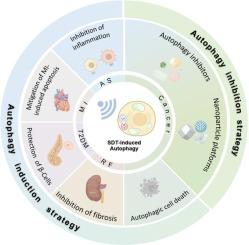通过调节自噬增强声动力治疗的疗效
IF 9.7
1区 化学
Q1 ACOUSTICS
引用次数: 0
摘要
声动力治疗(SDT)是一种将低强度超声与声敏剂相结合的无创治疗方式,在癌症和代谢性疾病的治疗中显示出巨大的潜力。然而,SDT诱导的自噬在疾病进展中起双重作用,因为它既可以促进细胞存活,也可以促进细胞死亡,其作用高度依赖于细胞类型和病理背景。这种复杂性强调了迫切需要调节自噬以优化SDT的治疗效果。因此,本文综述了旨在通过诱导或抑制自噬来提高SDT疗效的新兴调控策略。这些方法包括利用经典自噬抑制剂/诱导剂的药理学方法,以及基于纳米材料的策略,包括设计纳米载体或具有靶向递送和刺激反应释放能力的智能纳米声敏剂。本综述旨在为理解自噬在SDT中的双重作用以及实现其精确高效的调控提供一个全面的理论框架,从而为开发更有效的SDT治疗策略提供有价值的见解。本文章由计算机程序翻译,如有差异,请以英文原文为准。

Enhancing the efficacy of sonodynamic therapy through modulation of autophagy
Sonodynamic therapy (SDT), a noninvasive treatment modality that combines low intensity ultrasound with sonosensitizers, has shown significant potential in the treatment of cancer and metabolic diseases. However, SDT induced autophagy plays a dual role in disease progression, as it can promote either cell survival or cell death, and its effects are highly dependent on cell type and pathological context. This complexity underscores the urgent need for regulation of autophagy to optimize the therapeutic efficacy of SDT. Therefore, this review summarizes emerging regulatory strategies aimed at enhancing SDT efficacy through the induction or inhibition of autophagy. These encompass pharmacological approaches utilizing classic autophagy inhibitors/inducers, as well as nanomaterial-based strategies involving the design of nanocarriers or smart nano-sonosensitizers endowed with capabilities for targeted delivery and stimuli-responsive release. This review aims to provide a comprehensive theoretical framework for understanding the dual roles of autophagy in SDT and for achieving its precise and efficient regulation, thereby offering valuable insights for the development of more effective SDT based therapeutic strategies.
求助全文
通过发布文献求助,成功后即可免费获取论文全文。
去求助
来源期刊

Ultrasonics Sonochemistry
化学-化学综合
CiteScore
15.80
自引率
11.90%
发文量
361
审稿时长
59 days
期刊介绍:
Ultrasonics Sonochemistry stands as a premier international journal dedicated to the publication of high-quality research articles primarily focusing on chemical reactions and reactors induced by ultrasonic waves, known as sonochemistry. Beyond chemical reactions, the journal also welcomes contributions related to cavitation-induced events and processing, including sonoluminescence, and the transformation of materials on chemical, physical, and biological levels.
Since its inception in 1994, Ultrasonics Sonochemistry has consistently maintained a top ranking in the "Acoustics" category, reflecting its esteemed reputation in the field. The journal publishes exceptional papers covering various areas of ultrasonics and sonochemistry. Its contributions are highly regarded by both academia and industry stakeholders, demonstrating its relevance and impact in advancing research and innovation.
 求助内容:
求助内容: 应助结果提醒方式:
应助结果提醒方式:


